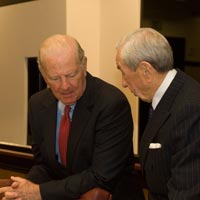On July 8, a bipartisan National War Powers Commission called upon the next administration to replace the controversial 1973 War Powers Resolution. Co-chaired by former Secretaries of State James A. Baker and Warren Christopher and composed of high-ranking former officials such as former Congressman Lee Hamilton, Former National Security Adviser Brent Scowcroft and Judge Abner Mikva, the privately-sponsored commission recommended the change to create more effective cooperation between the legislative and executive branches on when and how to deploy U.S. forces overseas. The U.S. Constitution gives both branches a role in approving the use of military force, but over the last two centuries, the relationship between the executive and legislature has been anything but cooperative. Some presidents have fully honored Congress's constitutional power to declare war by seeking preauthorization for the deployment of forces: e.g., President Woodrow Wilson in 1917; President Franklin Roosevelt in 1941; and George H. W. Bush before the liberation of Kuwait in 1991. More frequently, however, presidents have relied on their own constitutional commander-in-chief authority to deploy forces without seeking assent from Congress. In 1973, in an effort to stem this unilateralism as well as to roll-back the Nixon White House's accumulation of executive power in the closing days of the Vietnam War, Congress passed the War Powers Resolution over President Nixon's veto.
Should the Next President Advocate Replacing the War Powers Resolution?

